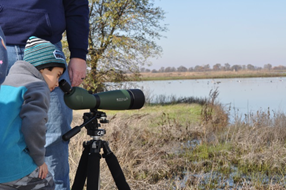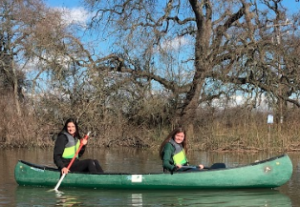Bringing Science to Life!
By Leah Wheeler, John Durand, Lisa Hegdahl, Neika Estey, Anya Pierre, Kitty Setberg, Lynn Byerly, Elaine Trull, and Sher Raquel
Climb the mountains and get their good tidings. Nature’s peace will flow into you as sunshine into trees.” – John Muir
With the Next Generation Science Standards (NGSS) and the Environmental Principles and Concepts (EP&Cs) at the forefront of science education, Galt Joint Union Elementary School District (GJUESD) educators have been working hard to connect their grade level standards to our local outdoor education program, Cosumnes River Preserve. Since the early 1990s, GJUESD has been fortunate to have such a unique natural setting in our own backyard and a partnership with this program. The Preserve offers several different environmental education and outdoor learning opportunities with the intent of sharing information to the public regarding the role the Preserve plays for the larger region, the importance of biodiversity and natural processes (both aquatic and terrestrial), the important role that citizens play in land stewardship, and the mission of the agencies and organizations that built and support (in perpetuity) the Preserve.
The Cosumnes River Preserve values the involvement of youth in recreation, education, and restoration. GJUESD is the lead agency coordinating a partnership with the Cosumnes River Preserve’s (CRP) environmental education program. John Durand leads the effort as the Education Coordinator for the Preserve and is a K-8 teacher for Galt and a member of its CA NGSS Early Implementation team.

One of the GJUESD visions is to provide outdoor educational opportunities for K-8 grade students to participate in environmental education to enhance academic learning and foster environmental stewardship. Utilizing the Preserve to augment and enhance classroom instruction has created a solid foundation for implementing the NGSS and EP&Cs. As students explore the natural world, they observe, experience and attempt to explain local phenomenon, providing authentic three-dimensional learning to occur both in the field and classroom.
First-grade teacher and NGSS Early Implementer, Sher Raquel, states that her first graders visit the Preserve every fall and are in awe of all the waterfowl that fly south to Galt. Migration is an amazing thing for first graders to witness. Students are surprised to learn how far the birds fly to a place where the weather is warmer and there is an abundance of food and that a preferred location is right here in Galt! First-grade NGSS standards introduce students to observation skills that allow them to begin constructing explanations of structure and function of different animals (LS1.A). There is an opportunity for students to begin to build the roots of the idea that natural systems go through cycles and processes required for their functioning (EP&C Principle 3, Concept A) as they begin to understand that the waterfowl are a part of this natural system. Getting the students out in a natural environment is so motivating for them to make observations, ask questions, and begin to build understanding in a natural setting.
Outdoor educational opportunities has a big impact on the way I have learned. It has especially helped me understand the curriculum we have been learning about the natural surroundings and about what could be causing what. It also gives me a strong idea on whether things are improving. For instance, I can be able to see or feel if the extreme weather has been decreasing or not. My final thought on outdoor educational opportunities is that, it is not only a beautiful sight and escape from todays distractions, but a great way to show kids and adults what pros and cons are occurring on the earth.”- Eliana E., 6th grade

Teachers have expressed that providing outdoor educational opportunities has directly impacted the youth in their classrooms. Sixth-grade teachers, Neika Estey, and Anya Pierre reported that opportunities like the Sly Park Environmental Living Program and planting oak trees at the Cosumnes River Preserve are great for students to experience the outdoors with a purpose. Sixth-grade students focused on the roles of water and the human impacts on Earth systems by researching the impacts of dams on rivers (ESS2.C and ESS3.C). Students researched the advantages and disadvantages of damming a river and argued from evidence prior to going out and canoeing on the Cosumnes River, one of the last undammed rivers in the nation (EP&C Principle 2, Concept B). Students are engaged both physically and mentally when seeing real science and how it applies to their world. Students also get to interact in person with scientists when experiencing field studies at the Preserve or Sly Park, and these interactions with scientists become an opportunity for students to see potential careers in science. Lisa Hegdahl, an eighth grade teacher stated, “Some students that, in class, don’t naturally engage with other students, are outside with members of the Bulldog Environmental Club talking to each other, helping each other plant trees, giving advice about how to paddle a canoe, and pointing out birds nesting in trees. They experience success and have an important role to play in the overall group.”
“It shows kids what nature is like and how fun it actually is to learn naturally instead of from a boring old textbook or science article and hopefully inspires them to protect and conserve nature.” – Nathaniel E., 6th Grade
Prior to the fifth graders going on their field study to the Preserve, they learned about decomposition and the movement of matter among plants, animals, and the environment (LS2.A and LS2.B). When fifth-grade teachers, Lynn Byerly, Kitty Setberg, and Elaine Trull, took their classes out during the bird migration, they reported that students were able to connect crane survival to the corn left in the field after harvesting. When students received science information from the scientists about the cranes spending their winters at the Preserve and that they came from as far away as Siberia, students realized that the actions they take in their local community of Galt, impacts the health of the Preserve and, ultimately, Earth (EP&C Principle 2, Concept C). Bringing science to the outdoors and letting students be immersed in nature creates a powerful connection between human choices and their impact on ecosystems.
“I was able to understand the science more because I saw it in real life. I learned new things that also connected to my Language Arts texts like how farmers harvest corn and warm it up. I was able to make more connections with what I was learning in class to what is happening in the real world. It’s pretty awesome that Sandhill cranes migrate to our little town and we were able to see them in real life instead of reading it from a book.”
-Brandon G., 5th Grade

Galt’s outdoor education programs support NGSS and EP&Cs by providing real life experiences for our students that connect them to local phenomena. Using these 5th grade students as an example, students were able to experience integrated learning of language arts and science by observing decomposing corn fields that provide food and shelter to the sandhill cranes that migrate to Galt. Teachers provided opportunity for students to further their learning about corn as an agricultural crop during their language arts time by connecting student understanding of the movement of matter in an ecosystem from NGSS (LS2.B) with a research project on what would happen to that particular ecosystem if the corn was removed (EP&C Principle 3 Concept C).
“It can teach how the real world of nature is and how cool or how beautiful it is. It can also show how hard taking care of nature is protecting it.”- Adam B., 6th grade

According to Lisa Hegdahl, the outdoor education programs support student learning of NGSS in their local environment. “Earlier in the school year, students engaged in a learning sequence about coastal ecosystems and the interaction of species with an emphasis on the human impact on these species and solutions to reduce these impacts. By getting outside to the Cosumnes River Preserve, students were able to connect their understanding of ecosystems and potential human impact to what they are seeing at the Preserve. For example, while we were canoeing, John Durand pointed out an invasive species, Water Primrose. The Water Primrose grows uncontrollably in the Cosumnes River and chokes off the waterway. Students were able to see the lush plant in person. Later in the year, students visited Horseshoe Lake which is a tributary of the Cosumnes River. Water Primrose, was cleared out of Horseshoe Lake as a way to improve habitat for giant garter snakes and a variety of birds.”
According to Lisa,“Students will also plant oak trees along the Cosumnes River to replace the oak habitat in order expand nest sites. Weather has not been on our side this year to plant yet, but the students saw the oaks on their canoeing trip.”
By connecting the NGSS and EP&C’s, students are directly experiencing the importance of human impact through their interaction with the outdoors and becoming one with nature. Bringing science to life for students by providing opportunities to connect classroom experiences to their local environment has been transformative. It has allowed students to make meaningful connections to the world around them. Galt is confident that the NGSS and EP&Cs will have lasting impacts for our students to be well-informed decision makers.







